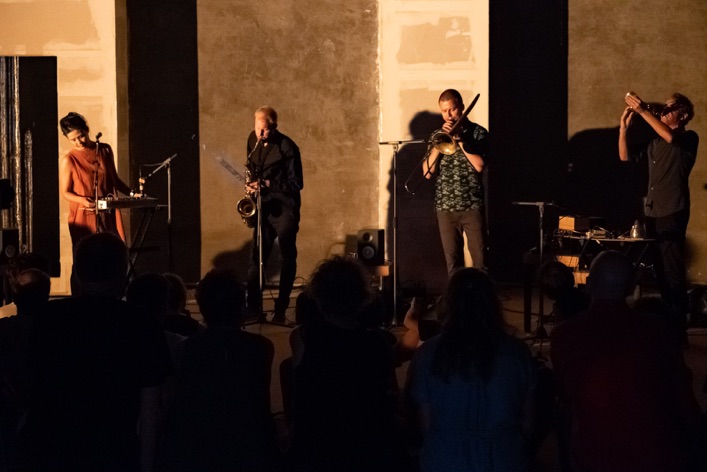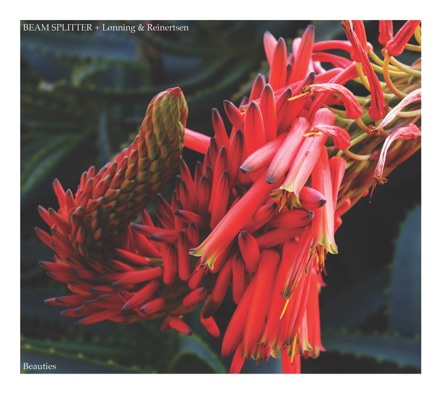Neither/Nor Records


Audrey Chen and Henrik Munkeby Nørtebø interviewed by Carlo Costa in September 2023 for the release of Beauties (n/n 023)
Carlo Costa: Beam Splitter often collaborates with other artists or bands. What interests you about collaborating with others generally? What sparked this particular collaboration with Eivind and Espen?
Henrik Munkeby Nørtebø: Eivind and Espen are like twins separated at birth, despite having wildly different personalities. They have worked as a tightly knit unit for almost two decades now, and are two of the most unique instrumentalists out there. They have developed ways of transcending the roles of their instruments, while still carrying a lot of music tradition, and utilize electronics as an extension of their expression. Their practice as the duo "Streifenjunko" is very specific, almost lab-like, and based on developing material over time, but as individuals they're still really open and flexible, and are often invited together into projects that are miles away from the specific duo material they produce. I think all these elements really resonate with the way Audrey and I live and work together, and the way we enjoy being challenged by people who operate on different ends of the spectrum. I played with the two of them for the first time in 2010, followed by occasional projects, and Audrey was a part of a large group with Eivind for some time. We hadn't played together in a small setting though, and the idea of a double duo/quartet had already existed for a while before finally coming into fruition through an invitation to make a commissioned work for "Asphalt festival" in Düsseldorf in 2018. We also really like hanging out together, and share an enthusiasm for eating and drinking good stuff, so that's also a central element!

Audrey Chen: I can only answer on my own personal relationship with electronics, and in fact, it's just my unique relationship with the one/two ciat lonbarde synths, (one of his original "fourses" synths from 2006 or 7 and a more contemporary "mr. grassi" module, both of which i've crudely connected). This touch based set up remains separate from my voice but is connected through me. It's entirely chaotic and I barely control the sonic output except by way of volume and touch triggering. But since it's been an integrated part of my set up for nearly 16 years, I feel I have an understanding and sensibility with its feral electronic nature.
HMN: I also to a certain degree have a "found objects" approach to my use of electronics, where various items have slotted in with the trombone over time. Generally mine and Audrey's choice of electronics also reflect our musical personalities pretty well, where I personally prefer keeping my sound sources on tighter reins, and letting the chaos element come from the situation or people I play with, while Audrey also in her solo work is actively being surprised by her chaos based synth. Neither of us use electronics to alter the sound of our instruments though (beyond microphone technique), which is a misconception regularly found in reviews about our work, haha.
My impression of Espen and Eivind is that they're definitely changing their tech setup more actively, and probably also practicing more together outside of concerts than Audrey and I do. And for this particular record, both of them are mixing dry signal with occasional electronics that affects their trumpet/sax output, as well as using "external" electronics. And Espen's scattered use of heavy reverb amazingly creates an illusion of all four of us being transported to that resonant space for a second. Beyond this though, I think all four of us are primarily driven by the manual acoustic instrumentation.
CC: Beam Splitter has been very active in the past few years, playing many shows all over the world. How has your music and process evolved over time?
HMN: We have definitely gotten louder over these past eight years, and our duo practice has deepened a lot through repetition and playing together in so many different situations and spaces. I personally have pushed my microphone technique to closer match Audrey's very "hot on the mic" approach, and there's always a healthy push and pull going on due to our contrasting personalities. And beyond our duo development, which I would say is a patient process, we do get a lot of impulse injections from all our collaborations, and also from the wide range of projects we are developing and taking part in individually.

CC: What is your relationship with recording? Is it a way to capture an instant of your ongoing work, or something else? What does it mean to record unedited, unprocessed improvisations such as these ones?
AC: I'm not a very recording centric person although I appreciate the process. Usually my records (or ones I'm involved with) manifest via an external source, either a bandmate or a label contacting me. My performances are best experienced in a live context and that's how I also most fully feel connected, moment by moment, year by year, to my ongoing practice. Recording in every aspect is a different process than this kind of connection. It is a kind of way to capture some essence of the language and spirit of the performance and I view my recording output more like a historical account which documents a moment in my life and a place where I am. Although this record with the quartet is long form and unedited (as was the spirit of the playing, interactions uninterrupted) I often cut recorded material into shorter bite sized vignettes more easily digested by the ear without the live component. So, instead of a longer narrative, I make the book into poems. But sometimes when the music is owned by many, in this case 4 persons, you need the entire story beginning to end, to feel the breadth and complexity of all the voices.
HMN: I have released records that are full length unedited concert performances (the trio with Nina de Heney and Raymond Strid is even two full concert sets), and used to be more dogmatic about avoiding overlapping or altering recorded material. In many ways I still feel the entire story is needed, like Audrey mentioned. But I guess I also have become more realistic about people's listening habits, combined with departing from fully acoustic music, which somehow makes the editing step seem less drastic. Earlier in my development the music I played changed much quicker, and I found that making records was the only way of producing something fixed from a very fleeting process. It was really important to sit down and choose a cross section of this process, and decide that "this is my music right now". Nowadays I really enjoy moving little sound files around for hours, and I view records as their own medium more than as documentation. But the material that ends up on my releases is always developed through improvisation and repetition, so it's just capturing the process from a different angle.
When it comes to our work with BEAM SPLITTER, which overlaps a lot with both our solo projects, the live performance will always be the ultimate format. The music is very physical, with every movement connected to the sound produced. And it contains both dynamic and frequency ranges that can't be fully captured on a record. Sending a new release out into the world, you just have hope for the best! It won't come across as intended when played through laptop speakers or on a low volume, but can give a good approximation when listened to with care. Each record, and the material that is up for selection for a record, dictates the process and format needed. And the quartet in this case might sound more processed than it actually is, so I think it might have felt too fragmented if we had cut it up into shorter pieces or added post production beyond the regular mixing/mastering procedure. We are really happy to release this disc with two of our favourite collaborators, and it definitely gives access to a moment that wouldn't be reachable otherwise.
Photo credits:
The album cover is a photo taken by Henrik Munkeby Nørstebø.
The photo of Audrey and Henrik was taken by Michael Breyer.
The photo of BEAM SPLITTER + Lønning & Reinertsen was taken by Andre Schuster.
